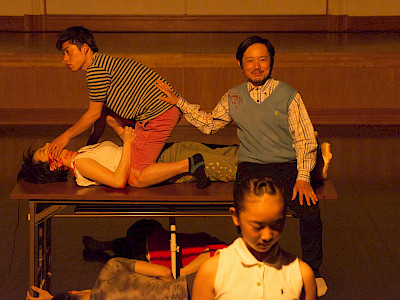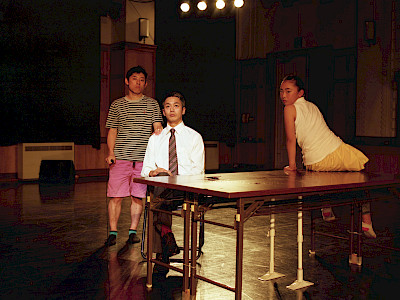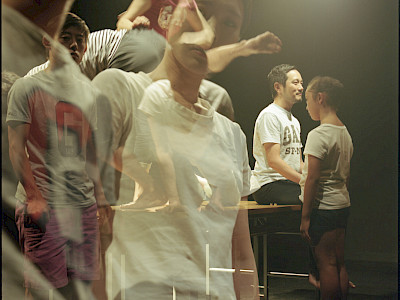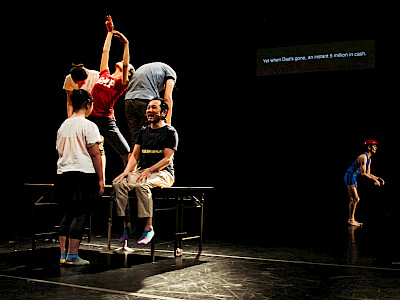12 — 16.05.2023
“What if dad dies?” Wouldn’t it be a pity not to have a life insurance, to make his death somehow productive? Midori Kurata conceived this piece following an encounter with an insurance policy salesman. It echoes the financial crisis in Japan, during which some people ended their lives to get insurance payouts for their families. The family of this Portrait is made of desires: a mother who struggles to pedal uphill and dreams of an electric bike, a daughter who has wanted to take dance lessons for years, and a son who wishes to study photography. They move around the stage as lightly as figurines on a music box; they compose and decompose tableaux vivants of family life while an insurance salesman touts the benefits of a 5 million yen cash payout from the father's death. The daughter is a teenager, yet we see her older version (at last!) dancing The Nutcracker. The breathtaking climaxes of Tchaikovsky set a rhythm matched by the insistent salesman. With a background in classical ballet, Kurata is one of the most fascinating theatre-makers in Japan today. In this profound yet lighthearted piece bordering on comedy, she portrays the unfathomable aspects of family relationships and a capitalist society in which it would be a pity not to profit from any opportunity.
FAMILY PORTRAIT
A conversation with Midori Kurata
Mélanie Drouère – Family Portrait is a theatrical and choreographic piece which is rather singular in your repertoire, Midori Kurata, in that it’s fictional whereas your works are mostly documentaries. You commissioned Jun Tsutsui to write the text.
What made you want to do this, and what themes did you suggest to him?
Midori Kurata – Contrary to appearances, the basis of this piece is as documentary in nature as my other performances. One day my husband told me that he had taken out a life insurance policy. The insurance company offered to present to us, him and me, the advantages of their product. The consultant explained to me the benefits I would receive if my husband “died today”. I found it quite contradictory to claim to want the best for families while extolling the hypothesis that my husband would die as soon as possible! That’s how the idea for this piece came about.
Why did you choose Jun Tsutsui, an author and director?
Jun Tsutsui is an Osaka-based artist-author who possesses the particularity of writing both funny and cruel texts on social issues. It was obvious to me that he would be able to bring out the zaniness of the situation while expressing the very pragmatic side of it, and to do so without heaviness. I gave him all the brochures the insurance company had given me, asking him to start the paragraphs with “What if dad died?”, and to turn it into material that resembles song lyrics, like a ritornello. I also suggested that he write the text in his language, the dialect of western Japan, which is very singable and much used by comedians.
How did you compose your cast?
I had the roles in mind from the start: father, mother, two small children and two grown-up children. Only the role of the consultant from the life insurance company came later, when our real consultant resigned! In choosing performers, my approach is to try to make the most of their own artistic personality on stage. This project originally came about through a request to collabo-rate with a photographer known for his self-portrait work. So I decided to have him appear on stage as he usually does, taking pictures of himself with the other performers. And, as he is small, I made him one of the young children. The wife, Misako Terada, who is a magnificent dancer, has – at the same time – that little something detached, distant, lunar, which I found very attractive for the role of the mother. As for Jun Tsutsui, I thought it was lush to offer the role of the father to this playwright. He rarely plays on stage, but he’s an excellent actor, and I’m delighted by his slightly cynical presence. Except for the person who plays the life insurance advisor, none of the performers has children, which was important to me, so that the whole group would create a family atmosphere. There’s now a genuine fake family on stage, and I think I instinctively chose these people because I felt they would bond off-set.
You are also one of the performers – what made you decide to be on stage?
I’ve always preferred to be inside the flow of the performance rather than outside of it, which is why I always participate in the pieces I create. In addition, this piece evokes a personal experience: classical dance. As a child, practising this art form allowed me to be appreciated by my parents. Growing up, I turned to contemporary dance – it’s more conceptual and not always so ‘lovely’. I had been trying to play the ideal girl for a long time, it took me a while to get past that. By having the little girl who grew-up appear in this piece, it was obvious to me that I would take on this role. Beyond the life insurance anecdote, it’s also and above-all a personal piece.
Specifically, how did you design the staging?
I had spent my youth studying and even ‘verifying’ my ballet-dancer form in a mirror. As this piece was conceived for collaboration with a photographer, I took the opportunity to work on the two-dimensional aspect of the piece. That’s why I directed the dancers by playing alongside them, but always while facing a mirror. I even gave them my director’s notes through mirrors. I wanted the rendering to be quasi-real, like a photograph. I worked on this dimension to instil something disconcerting, as found in classical ballet. Also, my baseline being the potential of each personality, it was quite complex to unite their expression on stage. And it was the music that saved me. The Nutcracker transmits all the “tops”: Jun Tsutsui’s lyrics, the dancers’ gestures or some general form that’s created… This system of relations between displacements and stage movements, this mould that is created is born from the essential, the most common element: the music.
- Interview by Mélanie Drouère, 5 April 2023, in collaboration with Aya Soejima (simultaneous translation) for the Festival d’Automne à Paris 2023.
- Family Portrait runs from 30 September to 4 October 2023 at the Maison de la culture du Japon à Paris as part of the Festival d’Automne à Paris.
Presentation: Kunstenfestivaldesarts, Les Brigittines
Direction and choreography: Midori Kurata | Assistant director: Naoyuki Hirasawa | Lighting: Rie Uomori | Sound: Toru Koda | Performers: Tatsunori Imamura, Midori Kurata, Riko Sakonuma, Kentaro Sato, Jun Tsutsui, Misako Terada, Kai Maetani | Text: Jun Tsutsui | Surtitle translation: Saeko Nagashima | Surtitle French translation: Aya Soejima and Philippe Achermann | Stage manager: Yohei Sogo | Production manager: Yoshimi Toyoyama
Production: akakilike
With the support of: The Saison Foundation
Acknowledgements: la Maison de la culture du Japon à Paris





